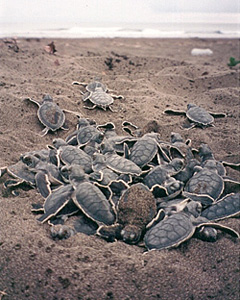 |
 |
 |
 Editorials | Environmental | November 2007 Editorials | Environmental | November 2007  
86% of Sea Turtle Species Threatened With Extinction
 Ken Burton - U.S. Fish and Wildlife Service Ken Burton - U.S. Fish and Wildlife Service
go to original


| | Emerging green turtle hatchlings head for water in Costa Rica. (Sebastian Troeng/Conservation International) |
Turtle conservation is like its namesake: it’s slow, but there are big rewards.

Marine turtles have thrived for more than 100 million years. But only the last few hundred years have given the huge, spectacular, prehistoric reptiles serious trouble.

And that’s where people like Earl Possardt, an international sea turtle specialist with the U.S. Fish and Wildlife Service, come in. Possardt is part of a bigger effort to rescue what remains of seven species of an animal that has managed, sometimes against formidable odds, to make it all the way into the 21st century.

In 2007 alone, the U.S. Fish and Wildlife Service directed international conservation grants totaling nearly $600,000 to 22 countries and conservation entities involved in sea turtle survival. Most of the money has gone to efforts to restore or safeguard turtle nesting areas. The funds also support conservation of the world’s largest nesting loggerhead population in Oman, and help preserve one of the two remaining large leatherback nesting areas that occur along the West African coast.

Possardt said that overall, he has seen some positive response, but acknowledges that progress is “a mixed bag. We know how to conserve turtles, but we also know it takes a long time.”

Myriad threats continue to plague sea turtles around the globe, but it was the growth of the shrimping industry following World War II that took a significant toll on turtle populations. Turtles are able to swim long distances under water, but must eventually surface for air. Trapped in shrimp trawls, thousands drowned. The eventual use of “excluder” devices by shrimp trawlers, which enable trapped turtles to escape while shrimp remain caught, has dramatically alleviated the problem.

But the turtles still face legal or illegal over-exploitation of their eggs or meat, depredation of eggs by predators, disorienting light pollution that can confuse nesting females and disorient hatchlings, and degradation of important habitat, including grass beds and coral reefs.

Poaching remains a potent threat. Last September, Fish and Wildlife Service law enforcement agents and authorities in Mexico arrested 12 people involved in the black market sea turtle trade. The 3-year undercover investigation snared suppliers, manufacturers, wholesalers, retailers and smugglers who were dealing in products made from hundreds of sea turtle skins or pieces of turtle shells.

If that isn’t enough, Mother Nature has placed its own natural restrictions on the turtles – hawksbill turtles may not reach sexual maturity until they are 30 years old; it can take loggerheads 12 to 30 years, and green sea turtles, somewhere between 20 and 50 years before they can reproduce, delaying the ability of populations to recover.

Because of some or all of those problems, species like the Pacific leatherback remain in dire shape; the East Pacific population, formerly the world’s largest leatherback nesting aggregation as recently as the 1980s, is now reduced to fewer than 500 females nesting annually on beaches in Mexico and Costa Rica. They face continued threats from poachers, and the Service and NOAA Fisheries continue to work with the fishing industry to minimize dangers to the turtles from long lines and gillnets.

But there are bright spots. Possardt notes that the Kemp’s ridley sea turtle represents a success story. On the verge of extinction in the 1980s, the Kemp’s ridley was down to as few as 700 known nests in 1985, from the tens of thousands of nests counted annually in the 1940s, due to the aggressive harvest of eggs and females as well as a high mortality from shrimp trawlers. But a serious conservation effort on the part of the Mexican government, initiated in the 1960s and joined by the Service in the 1970s, managed to turn the tide for the Kemp’s ridley, and today the turtle is in much better shape.

Of the seven sea turtle species that remain on the planet, six are considered imperiled; only the flatback turtle, found in the waters off Australia, is not on anyone’s endangered list.

Turtle grants are made possible by the Marine Turtle Conservation Act of 2004, enacted by the Congress and administered by the Service and are designed to ensure the long-term survival of sea turtles by providing a dedicated fund supporting international conservation efforts.

“It’s a long-term job,” said Possardt. “In one human lifetime, you have to look for small victories. In the larger picture, all of those will begin to add up, and through the combined multinational efforts of governments, conservation organizations and the fishing industry, we can save the sea turtles. In the process, we will also create more sustainable marine ecosystems for humanity.”

For more information about the U.S. Fish and Wildlife Service, visit FWS.gov | 
 | |
 |



